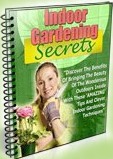Archive for the ‘General Gardening Tips’ Category
 HOME VEGETABLE GARDENING
HOME VEGETABLE GARDENING
Home vegetable gardening is a wonderful and rewarding activity. It is a relaxing and inexpensive way to pass your leisure hours. Home vegetable gardening is healthy because it provides exercise and gets you out in the fresh air. It gives you a feeling of accomplishment to grow food with your own hands. Home vegetable gardening also helps cut down on the grocery bills. You can take your produce directly to the kitchen, or you can freeze or preserve your vegetable for use during the winter. Of course, you can also share the produce from your garden with friends and relatives. You don’t even need a plot of land to do home vegetable gardening, because many vegetables can be grown indoors in containers.
When you start home vegetable gardening you must consider several things. First, what sort of ground will you be planting in? Is it at the top of a hill or in a valley? Valleys are more susceptible to cold than hilltops. Is the ground exposed to wind? Such things create “micro-climates”, and some crops grow better in cooler or warmer micro-climates than others.
How much sunlight does your garden location get? Some crops require a lot of sunlight, while others do better in the shade. Can you increase the sunlight your garden plot receives by pruning back other foliage?
Are there trees growing on the ground where you plan to do home vegetable gardening? Trees can provide necessary shade for some crops like cucumbers, beets, carrots, cauliflower, radishes and spinach. But they also take water and nutrients from the soil. Plant your vegetable garden no closer than the outer reaches of a tree’s branches; preferable a few feet farther away than that.
If your yard has no flat areas on which to do home vegetable gardening, try terracing your ground. You can do that with timber or stone walls. Plant vegetables that like the warmest, sunniest conditions on the highest terraces, and those that can thrive in cooler temperatures at the bottom.
No matter how small your garden plot is, you can modify your garden’s mini-climate by using windbreaks, shade plants, mulches and irrigation. In places where the growing season is short, you can start some of your vegetables indoors in seed flats. These are small, open, well drained wooden boxes, usually twelve by twenty-four inches, and no less than three inches deep. You can even use things like cut-off milk containers, margarine or cottage cheese tubs, or foam or paper cups. Be sure to poke holes in the bottoms for drainage. When outdoor conditions are tight, transfer your baby plants to your garden.
Give your garden some time and effort, and before long you’ll be serving the fruits of your labour at the table.
 41-Container Gardening
41-Container Gardening
With the growing number of the population choosing to live in apartments and condos, many believe that their days of growing beautiful and useful plants is over. Thankfully this doesn’t have to be the case. A growing trend among yard less people is the option of container gardening. There are five key elements to keep in mind when growing your own container garden. The type of containers used, what kind of growing mixture, exposure to sunlight, fertilizer, and watering habits all need to be considered before starting your container paradise.
Container type is an important aspect of this style of gardening. You will want the containers to match or enhance your outdoor patio, yet be a healthy environment for the plants you want to grow. Wood pots can be prone to rotting. Cedar or redwood are rot resistant and can be used without staining. If using wood pots, be sure that it is untreated wood to avoid any harmful chemicals polluting your plants. Plastic pots deteriorate quickly in the sun and won’t last very long. While they are pretty, terra cotta pots dry out fast making them prone to cracking and breaking. Glazed ceramic pots are a good option for container gardening. Just be sure there are sufficient drainage holes in the bottom.
Your growing mixture will largely depend on what type of plants you want to grow. Due to the small space the plants have to thrive in, be sure to the mixture will allow proper drainage. You want the soil to retain moisture, but also drain off to avoid over watering. Check into the growing requirements of your plants to see if any sand should be added to the growing mixture. The right mix of soil and other components is very important in container gardening.
Once again when determining the amount of sunlight your container garden will need, check the requirements for the plants. This is especially true with flowers. Vegetables tend to need an average of five hours of sunlight daily.
In container gardening, fertilizer is a key element. Since the plants only have a limited amount of soil to draw nutrients from it is necessary to help them along. The recommended interval for fertilizing plants is every other time you water. Liquid seaweed is an excellent plant booster, just be sure to provide the plants with a wide variety of nutrients for the best results.
You will find with your container garden that watering is critically important. It may take some time to determine exactly how much and when to water. All plants are different and it is important to know what your plants need. Especially in very hot weather you will find that plants may need to be watered daily.
Container gardening is a rewarding hobby that allows even apartment and city dwellers to enjoy a piece of the great outdoors. Decide what types of plants you want to grow, have your materials ready, and be prepared to reap the rewards of your labor.
